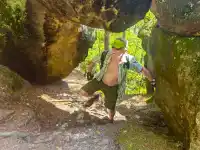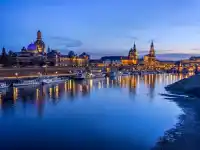Scootering Dresden along the Elbe River from Dresden to Pillnitz Palace: 42 km of views, laughter, and muddy sneakers. Adventure in Saxony starts here.
Setting Off from Dresden Neustadt
After checking in and spending our first night in Dresden’s Neustadt, we decided to sneak under the bridges and follow the Elbe cycle path toward Pillnitz — on our Kostka scooters, of course.
Our goal: the Water Palace (Wasserpalais), once the summer residence of Saxon kings and the place where guests arrived by boat straight from the Elbe. It sounded like an elegant ride — and mostly, it was.
The Water Palace of Pillnitz
The royal complex lies about 15 km southeast of Dresden’s center, directly on the Elbe’s bank — an ideal route for scooters. It consists of three main parts: the Water Palace (Wasserpalais), the Mountain Palace (Bergpalais), and the New Palace (Neues Palais), surrounded by grand gardens and paths designed for slow strolls, not muddy adventurers.
Guidebooks describe it as majestic. Reality? Even better.
Scootering Along the Elbe River
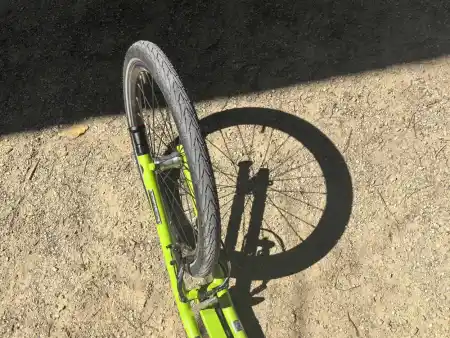


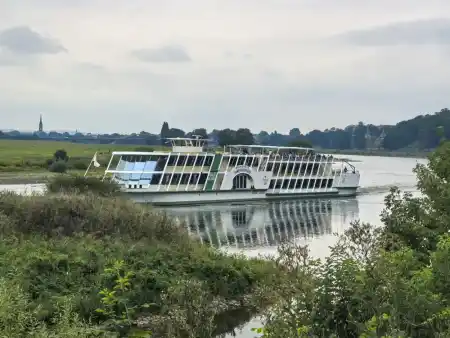
We rolled eastward, chasing our shadows and following the sun’s reflections on the river as our natural compass. Thirty-five kilometers ahead — a perfect day on two wheels.
Dresden, like many European cities, lives by its river. The Elbe Cycle Path runs along both banks, revealing parks, meadows, small ports, and hilltop villas. Every bend brought a postcard view — or at least another excuse to stop and take photos.
There was water everywhere — except in our bottles. Ten kilometers in, not a single kiosk, not a single fountain. Lesson learned: a bottle holder on a scooter isn’t just a gadget. It’s survival gear.
For the first half, smooth asphalt made us fly. We even kept pace with a tourist boat heading to Pillnitz. Sure, for €30 those tourists got a comfy seat and a beer. But they missed the rush of air, the rhythm of movement, the simple joy of stopping wherever you like — midges, sweat, and endorphins included.
Kostka footbike: from Asphalt to Adventure
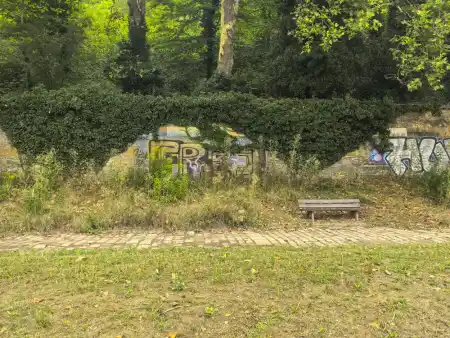
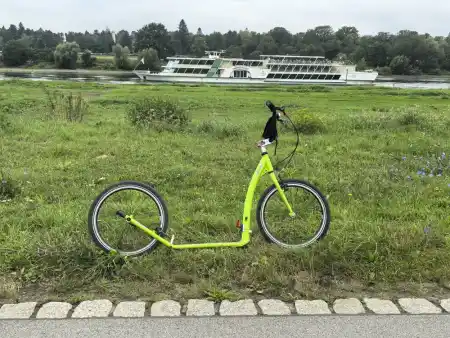

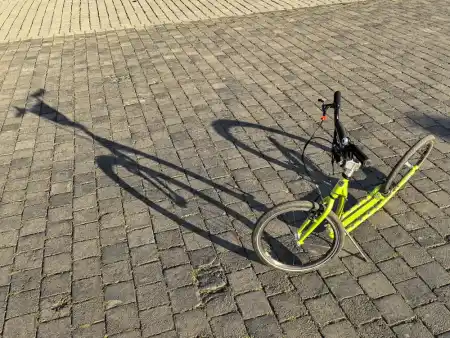
Halfway through, the asphalt gave way to cobblestones and rough terrain that felt more like an ancient Via Appia Roman road. That’s when Janko had to admit: his Rebel Fold scooter was not exactly built for medieval surfaces.
With Kostka, the rule is simple: the bigger the front wheel, the smoother the ride. Larger wheels mean better inertia and fewer pushes — something we learned not from a manual, but from 15 kilometers of real-life testing.
At around 18 km/h, I realized I was pushing too often, wasting energy. When I slowed my rhythm and pushed less, I actually went faster. Scooter zen, achieved.
The Waterworks Detour
The last part of the official route to the palace led past a massive waterworks complex. Beautiful new asphalt, perfect for riding — until the sign said STOP. No pedestrians, no cyclists. The detour was a kilometer back through heavy traffic. We weren’t in the mood.
“We’ll just sneak along the river,” I said. Famous last words.
The first barrier didn’t stop us. Neither did the second. But halfway through, the path ended in a construction site — mud, excavators, and a gushing stream from a broken water pipe. We pushed on anyway. First puddles, then swamps. Soon I was ankle-deep in mud, shoes squishing, socks beyond redemption.
Cursing in three languages, we kept going. A kilometer later, dry land — everywhere except in our sneakers.
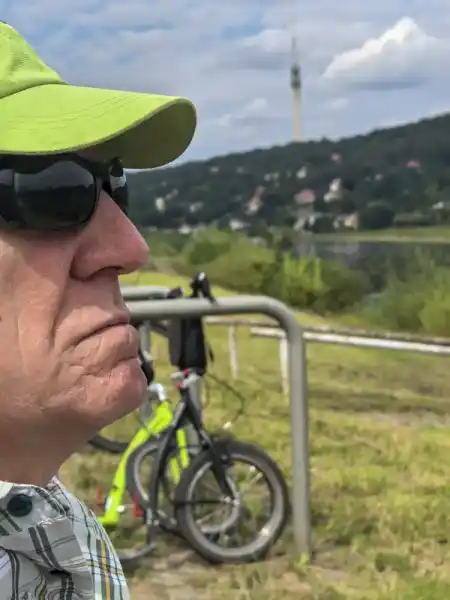
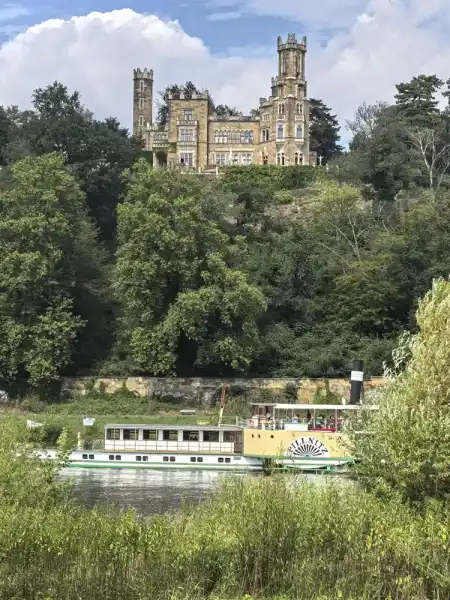
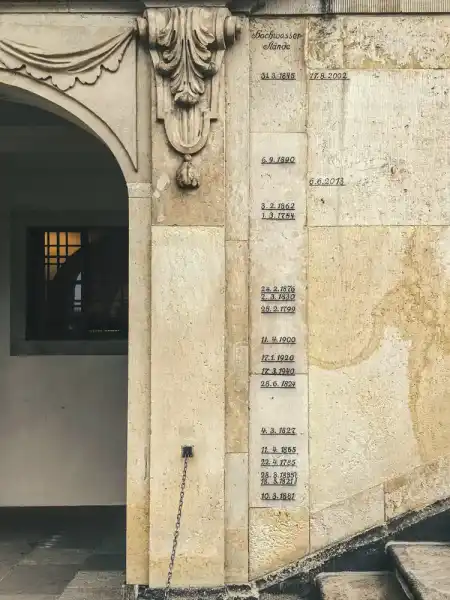
Arrival at Pillnitz Palace
Finally, the grand entrance appeared — stairs leading straight from the river to the royal gardens. The facade was majestic; our feet were not. I stared at the Water Palace and wondered: “Did the Saxon kings ever have to deal with wet socks? Probably not. They didn’t have Kostka scooters back in the 14th century.”
The park is vast and manicured, filled with themed gardens, an orangery, and a 250-year-old camellia protected by a glass pavilion. There’s even a museum dedicated to Saxon royal life — but we skipped it.
Why?
No sock dryers. No scooter parking. Priorities.



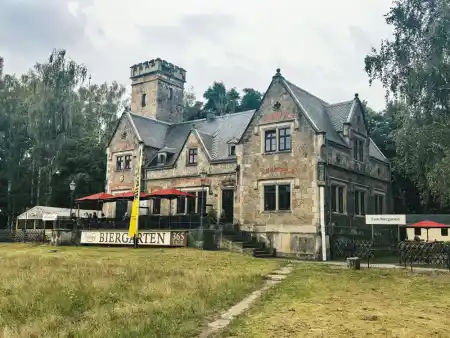
Biergarten Salvation
Instead, we crossed the river by ferry to a Biergarten on the opposite bank. That’s where our last euros disappeared — in exchange for cold beer and DDR-style bratwurst (worth every cent).
From there, we could see two other rebels ignoring the “No cyclists” sign and trudging through the same mud we’d just escaped. We raised our beers in silent solidarity. Brave fools.
Red Asphalt and Bruised Knees
The way back felt faster — the wind at our backs, the path dry and red under the sunset. I felt unstoppable… until my knees painted matching red marks on the pavement.
Lesson learned the hard way: Never ride fast in wet sneakers. Never trust perfect asphalt.
There are two ways to deal with a fall — hospital or macho mode. I chose the latter.
Nothing broken, just scratched pride and stinging knees. The next morning, moving them hurt more than an entire night of bad decisions. When someone on the train home asked, “What happened to your knees?” I just said one word: Scootering.
Back in Dresden

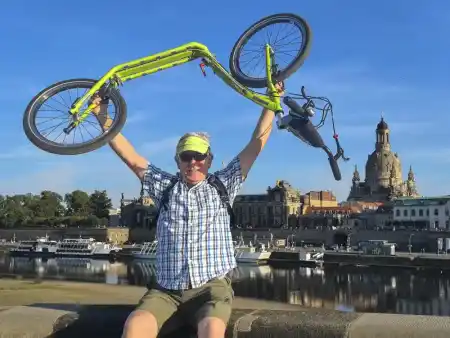

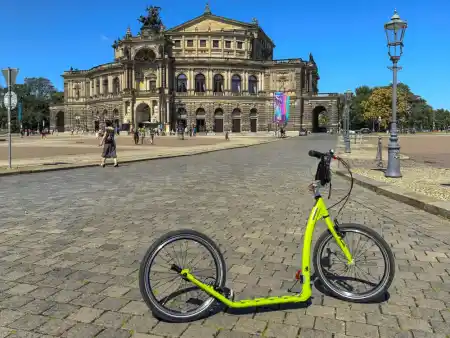
Dresden: Along the Elbe. We made it back under the first bridge by sunset. Johny asked: “Want to stop by a doctor?”
I grinned: “When you fall off a horse, you get back on.”
The city lights came on. I lifted the scooter to the sun’s last rays. East and west met — just like our trip.
42 kilometers. Two bruised knees. Two beers. One vegan sausage. Dresden along the Elbe River is simply beautiful.
The Scooterist’s 10 Commandments
Dresden: Along the Elbe on footbikes
- Wear long pants and sleeves — they save your skin.
- Gloves are a must. Trust me, road rash on your palms is hell (especially if you type for a living).
- If you see a “No cycling” sign — obey it. Or bring a fishing license and flippers.
- Train your push technique. Less is more.
- The Elbe path is flat but watch out for headwinds.
- Scooters beat bikes for city touring — lighter, simpler, easier to stop and explore.
- Bring a water bottle holder. Hydration matters.
- Keep your backpack small; balance is key.
- Don’t overdo it — 30 km a day is plenty.
- Always end your ride downtown. Dresden at sunset is magic.



